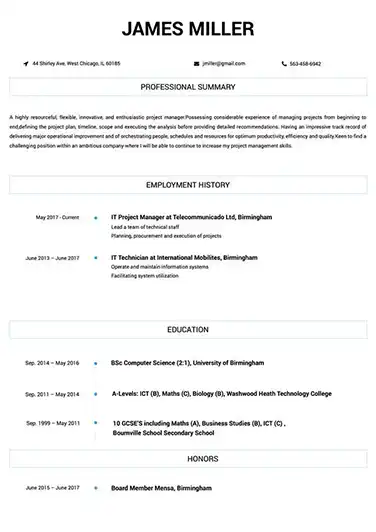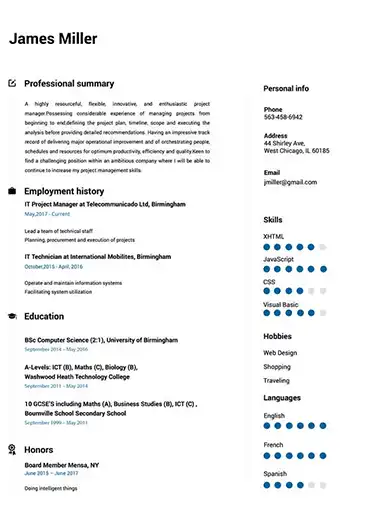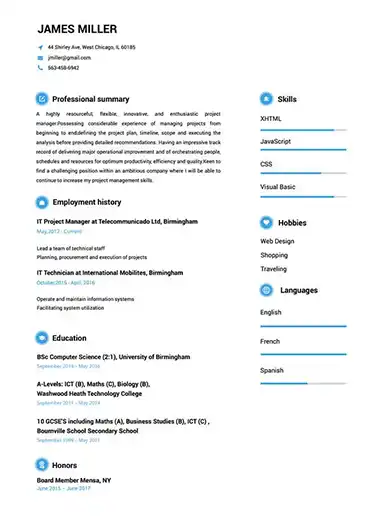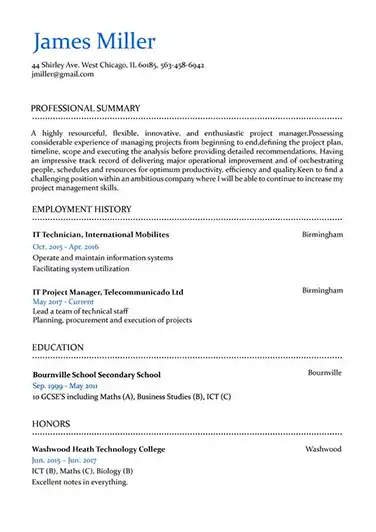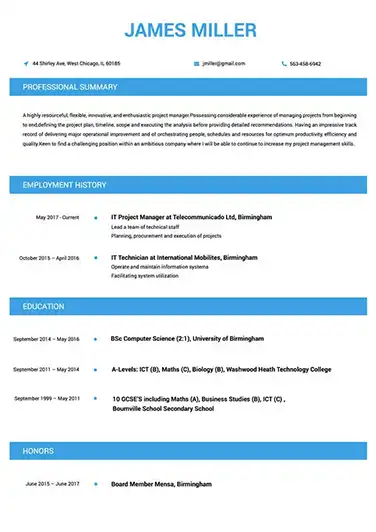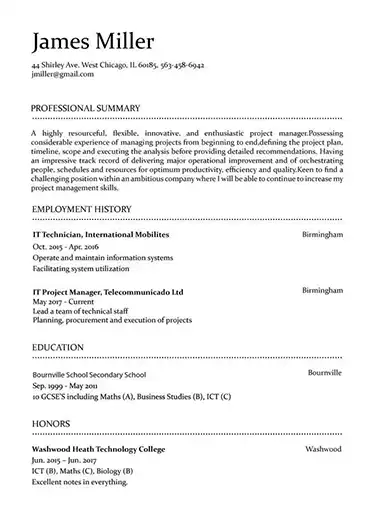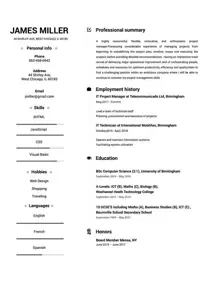 Use This Template
Use This Template
Build your resume in 15 minutes
Create an awesome resume that meets the expectations of potential employers with our selection of professional, field-tested resume templates.
Mechanic: Resume Samples & Writing Guide
berniesmith93@outlook.com
779-543-2794
Employment history
- Repair and maintain hydraulic and electrical systems
- Perform preventive maintenance on vehicles, machinery, and equipment
- Adjust, align, and calibrate vehicles, machinery, and equipment
- Inspect and test vehicles, machinery, and equipment to diagnose malfunctions
- Repair and maintain hydraulic and electrical systems
- Perform regular maintenance checks and tune-ups on vehicles, machinery, and equipment
- Maintain records of all maintenance and repairs performed on vehicles, machinery, and equipment
- Use specialized tools and diagnostic equipment to repair and service vehicles, machinery, and equipment
- Perform regular maintenance checks and tune-ups on vehicles, machinery, and equipment
Education
Skills
Do you already have a resume? Use our PDF converter and edit your resume.
oliverkelly@outlook.com
741-332-6256
Employment history
- Ensure that all safety procedures and protocols are followed while performing maintenance and repairs
- Keep work area clean and organized
- Adjust, align, and calibrate vehicles, machinery, and equipment
- Provide customer service to clients regarding maintenance and repair issues
- Inspect and test vehicles, machinery, and equipment to diagnose malfunctions
- Use specialized tools and diagnostic equipment to repair and service vehicles, machinery, and equipment
- Ensure that all safety procedures and protocols are followed while performing maintenance and repairs
- Perform regular maintenance checks and tune-ups on vehicles, machinery, and equipment
- Perform routine maintenance and repairs on vehicles, machinery, and equipment
Education
Skills
turnerfrancis40@zoho.com
761-496-2993
Professional Summary
Employment history
- Use specialized tools and diagnostic equipment to repair and service vehicles, machinery, and equipment
- Troubleshoot and diagnose problems with vehicles, machinery, and equipment
- Inspect and test vehicles, machinery, and equipment to diagnose malfunctions
- Perform regular maintenance checks and tune-ups on vehicles, machinery, and equipment
- Use specialized tools and diagnostic equipment to repair and service vehicles, machinery, and equipment
- Inspect and test vehicles, machinery, and equipment to diagnose malfunctions
- Follow manufacturer's instructions and established procedures to perform maintenance and repairs
- Keep work area clean and organized
- Perform routine maintenance and repairs on vehicles, machinery, and equipment
Education
Skills
greenstanley@mail.com
715-713-9980
Professional Summary
Employment history
- Ensure that all safety procedures and protocols are followed while performing maintenance and repairs
- Use specialized tools and diagnostic equipment to repair and service vehicles, machinery, and equipment
- Troubleshoot and diagnose problems with vehicles, machinery, and equipment
- Diagnose mechanical problems and determine the best course of action for repair
- Keep work area clean and organized
- Inspect and test vehicles, machinery, and equipment to diagnose malfunctions
- Ensure that all safety procedures and protocols are followed while performing maintenance and repairs
- Follow manufacturer's instructions and established procedures to perform maintenance and repairs
- Provide customer service to clients regarding maintenance and repair issues
Education
Skills
turnermax@hotmail.com
965-747-0368
Employment history
- Perform preventive maintenance on vehicles, machinery, and equipment
- Follow manufacturer's instructions and established procedures to perform maintenance and repairs
- Repair and replace worn and damaged parts, such as gaskets, seals, and bearings
- Troubleshoot and diagnose problems with vehicles, machinery, and equipment
- Follow manufacturer's instructions and established procedures to perform maintenance and repairs
- Maintain records of all maintenance and repairs performed on vehicles, machinery, and equipment
- Inspect and test vehicles, machinery, and equipment to diagnose malfunctions
- Maintain records of all maintenance and repairs performed on vehicles, machinery, and equipment
- Perform routine maintenance and repairs on vehicles, machinery, and equipment
Education
Skills
Not in love with this template? Browse our full library of resume templates
Introduction
You have loved working on cars since you were a kid. You can fix anything that has four wheels and an engine. You can make a VW bug purr like a kitten and go as fast as a Ferrari. Now all you have to do is convince an employer of this so they will give you a job.
Most professionals are very good at what they do, but when it comes to convincing employers of this, they struggle. This article will help you to create a resume that highlights your skills and experience and enables employers to understand your qualifications and the benefits you will bring to their organization. It will show you how to format the resume to catch the employer’s attention, make you stand out from other applicants, and get you invited to an interview. Specifically, it will show you how to:
- Demonstrate your technical skills as well as the soft skills required for the job
- Help you to get past the Applicant Tracking Systems (ATS) employers use to screen candidates
- Highlight your experience and show how this qualifies you for the job you are applying to
- Enable you to customize the resume for each job you apply to quickly
- Convince employers that you’re the right person for the job and encourage them to invite you for an interview
It will also walk you through essential concepts such as using keywords and phrases, organizing your resume to put the most critical information first, and creating a resume that is visually appealing and draws the reader’s attention to the key areas. The article will provide you examples of resumes and introduce you to the Resumebuild tool, which you can use to quickly and easily create a customized resume that will help you get your dream job as a mechanic.
Resume templates
How to Write the Perfect Mechanic Resume
Creating the perfect resume is very similar to building the perfect car. You start with a strong framework, add the necessary components, making sure the content you include matches the type of journey you will be taking, and dress it up to make it attractive. If done correctly, your resume will catch an employer's attention, convince them to review your skills, talents, and experience, and motivate them to invite you in for an interview.
Formatting Your Resume
The format of the resume is probably the most critical part of the process of creating an effective resume. The format helps you logically organize the information, enables the reader to find the specific information they’re interested in, and allows both ATS and human readers to identify your qualifications for the job quickly. Most importantly, it helps you stand out from the other applicants. While there are many different formats you can choose for a resume, the most effective ones will accomplish these goals. A proper format will also enable you to easily customize the document for each job you apply to. This is important because it distinguishes you from other applicants who are submitting generic resumes.
Note that the layout is well organized, helps the reader move through the resume and a logical fashion, provides the vital information first followed by the details, and makes it easy for the employer to contact you to invite you to the interview.
Let’s walk through the resume, so you understand the format.
The column on the left provides the reader with a quick summary of the information that is important to them. First is your Name and Contact Information, so they will understand whose resume they are reading and can quickly contact you. Your contact information should include:
- Your Name
- Phone Number
- A link to your LinkedIn profile
- The area in which you live
The next section is a summary list of your Skills. Employers want to quickly establish that you have the skills and background required for the job they are trying to fill. Information provided in this section includes soft skills that contribute to your ability to do the job and be a good employee. The type of skills you should include are discussed in more detail later in this article.
You should also include some Personal Information the recruiter can relate to. Employers hire people, not resumes. They want to make sure that not only are you qualified for the job, but you will be a good fit for their organization and contribute to their culture. This information can include your hobbies, interests, and activities.
The balance of the page contains the Body of the resume. The body of the resume is designed to convince the employer that you have the right experience and are the type of person they would like to work with. This includes your experience, career accomplishments, education, and any recognition you have received. If the interviewer is taking the time to review these sections, you are well on your way to convincing them to invite you for an interview.
The first section of the body of the resume is a brief statement about your Career Objective. Employers are interested in learning about your career goals and how your next job will contribute to these. Your objective should be stated clearly, demonstrate your ambition and willingness to grow, and should align with the position you are applying to.
An Objective statement may look like this:
Experienced Auto Mechanic with advanced skills in repairing contemporary and classic vehicles seeking an opportunity with a progressive service organization. The ideal situation will utilize my ASE certification and specialization with complex electrical systems while offering the opportunity for professional development and additional training.
The next section as a Professional Summary. This should consist of 2 to 3 sentences that summarize your career history and highlight the contributions you made in your previous positions. Think of this as your ‘brag’ statement. It is your chance to quickly and concisely tell the employer why they should hire you. Keep in mind that each section of your resume should address the job you’re applying to and the reason the employer should hire you. Every statement you make and each piece of information you provide should demonstrate how you will help the employer achieve their business objectives. Make sure you use impactful keywords and phrases that align with the job you are applying for.
Here is a sample Summary Statement for a Mechanic:
Automotive Mechanic with twelve years of experience repairing a wide variety of vehicles, including gas, diesel, and electric. Possess advanced skills working on electrical systems, fuel systems, and suspensions. Familiar with both domestic and imported automobiles. Adept at working directly with customers to diagnose, triage, and repair their vehicles and creating long-term relationships and repeat business. ASE Certified.
The next section in the body of the resume is your Employment History. Since you have already summarized your skills and qualifications, it is now time to provide proof of your ability to do this. The employment history section will detail the work you have done, which has enabled you to develop the experience, talent, and skills needed for the position you’re applying to. This is the proof behind the claims you made in the previous sections of the resume.
The employment section should detail your previous positions going back no more than ten years. Jobs are listed in reverse chronological order, with the most recent job being first. The information for each position listing should include:
- Job Title
- Employer’s Name
- Location including, City and State
- Dates you were Employed with the Organization
- A Brief Description of the Duties you Performed
The most important information you can convey in each of the job listings is your achievements and the contributions you made to the employer’s business objectives. Avoid listing responsibilities and tasks. Focus on your achievements and include specific metrics for each one of these. Metrics are numbers that demonstrate what you achieved. These can be in the form of dollars, percentages, and numbers. Metrics for a Mechanic’s resume may include the number of vehicles serviced per day, the amount of time saved while performing a specific service, the service revenues you generated for the company, or the number of different types of repairs you are qualified to perform.
This is a sample Employment Listing for a Mechanic’s resume:
Lead Mechanic
Westcoast Automotive - San Diego, CA Jan 2008 - Present
Serviced a wide variety of vehicles, both new and used, from manufacturers including Toyota, Ford, Chrysler, and Mercedes. Acted as the team leader, mentoring junior mechanics and working with management to balance the workload.
- Serviced an average of six vehicles per shift
- Generated over $600K in service revenues for the dealership each year
- Trained 20 new junior mechanics, enabling to advance to more senior positions within the organization
- Helped design an updated workflow for the service department, resulting in a 20% cost savings
After you’ve completed the employment history, the next section you should turn your attention to is Education and Training. Employers want to ensure that you have the necessary training to do the job and want to identify any training requirements you have. The education section should start with the highest degree you have earned and the essential courses you took while in school. Once you’ve documented your formal education, you should move on to any specialized training you have received. This can include specific courses about individual systems within an automobile, and the certifications you received as a Mechanic.
The Education and Training section in a Mechanic’s resume may look like this:
Associates of Science, AS - Automotive Repair
Palomar Community College 2000
ASE - Series A 1-8 Certifications
The final selection in the body of a resume is any Honors and Awards you are received or other recognition from your employers. This enables a recruiter to understand that other people have recognized your achievements and qualifications.
What Recruiters Look For
As mentioned earlier, recruiters look for specific items when reviewing a resume. It is commonly believed that recruiters will spend only 7 to 10 seconds scanning your resume for the first time. (Source) This means that you have to quickly capture their attention so that they will take the time to review your entire resume in more detail to learn more about your qualifications. Formatting your resume correctly will enable you to do this. However, the content is also important because it keeps the recruiter’s attention and motivates them to continue reading each section of the resume.
Some of the things recruiters look for in a resume and which they believe is essential are:
- Abilities and skills that match the requirements of the job
- Experience in similar positions and with related organizations
- The appropriate training and education required for the position
- Accomplishments you’ve achieved and the contributions you’ve made in your previous jobs
- Interests, hobbies, and volunteer work performed outside of work which demonstrate your personality
- A direct, concise, and professional writing style which communicates your qualifications clearly
- An attractive format that is easy to read and draws attention to the vital sections of the resume
Following the correct format and including the right content will help you stand out from other applicants and will result in more invitations to job interviews.
What Skills to Mention
People often struggle when determining what skills they should include in their resume. As a mechanic, you have a great many skills. These include technical skills directly related to how you perform your job and impact your ability to repair vehicles. You also have soft skills such as your ability to communicate, documenting the work you do, and interacting with customers, coworkers, and the management team. Listing all of these is not practical, so you want to make sure you only list the most important ones.
The easiest way to determine what skills you should list in your resume is to review the job posting and identify what skills the employer is interested in. If you’re qualified for the position, you should have these same skills and can include them in the resume. Again, only include skills that the employer is interested in, and that will help them to accomplish their organizational objectives.
Some skills you can include in a resume for a Mechanic’s position are:
- Troubleshooting and diagnostics
- CODA engine analysis
- System repairs, including electrical, mechanical, hydraulic and others
- Use of a wide range of tools and equipment
- Ability to use both online and hard copy repair manuals
- Ability to document the repairs and complete timesheets
- Time management
- Organization and attention to detail
- Customer service
- Mentoring and training skills
These are just a few of the skills you should consider including. Note that there are both hard skills and soft skills included in the list.
Highlighting your Career Progression
As pointed out earlier, the primary purpose of the employment history section is to detail your previous job experience and to highlight your accomplishments, and the contributions you’ve made to other employers. However, another essential purpose of this section is to demonstrate continuous progress in your career. The employment history is written in reverse chronological order with your most recent position at the top, followed by the previous positions. There should be a steady progression of responsibilities, duties, and expertise for each of your jobs. This will demonstrate how you learned something in each job and applied it to the subsequent role. It communicates your desire to advance your career and that the position you are currently applying to will help you do this. Employers want to see personal development because they’re hoping that this will continue within their organization once they hire you. It is easier for an employer to promote from within than to recruit talent from outside of the organization.
The Resume Objective
The Objective is the first section on the main body of your resume. It tells the employer what your career objectives are and why you are applying for this specific position. The trap most people fall into is making this objective about themselves. As mentioned earlier, every section of the resume should resonate with the employer and help them understand how you will help them attain their business objectives. Even though you may feel strongly about your career objective, make sure that you state this in the context of what the employer is looking for. This will help set the tone of the resume and will enable the employer to picture you in the role for which they are hiring.
The Resume Summary
If you have some experience in the industry and the position you are applying for, you will use a Summary in place of the Objective at the top of your resume. The purpose of this section is to provide a summary of your qualifications for the position. This will convince the recruiter to continue exploring the rest of the resume to learn more about you and to confirm that they should invite you in for an interview. Again, the summary should be written to address the employer’s requirements rather than your career history. It is easy to fall into the trap of describing how great you are based on your previous experience, talents, and skills. However, if none of these are relevant to the job the employer is trying to fill, it will fall on deaf ears. Before writing the summary section, you should complete the bulk of the resume and use the information provided in these sections as the basis for your summary. You may also want to re-read the job posting so that the employer’s requirements are fresh in your mind. The summary section should only be 2 to 3 concise sentences that highlight the essential skills, talents, and experience you have related to the job you’re applying to.
Why are Customer Service Skills Important for a Mechanic?
As previously discussed, you should include both hard skills and soft skills in your resume. Hard skills are the technical skills you need to accomplish your job. Soft skills are not specific to the job you’re applying for but will help you perform the work and to function within the organization. The most important soft skill you can include in your resume as a Mechanic is customer service skills. These are the qualities that help you to interact with the public as well as your coworkers and the management team. Customer service skills include empathy, communication, and negotiation. They help you understand the issues customers are having with their vehicle, determine what repairs are needed, and communicate the amount of time and money required to complete them. Customer service skills also enable you to deal with customers who may be upset or frustrated because of the issues they are having with their vehicle. No matter how good of a Mechanic you may be, having excellent customer service skills is vital to the employer and will help distinguish you from the other applicants.
What if I Have Limited Experience as a Mechanic?
Many people with limited experience in their field or industry struggle when writing resumes. This is because they are concerned about their lack of experience and work history. If this sounds familiar and you share these concerns, then you’re in luck. There are ways you can create a resume that emphasizes your skills and talents, and minimizes the importance of your work experience.
The format and content of a resume for somebody with limited work experience is a little different than a typical chronological resume. The objective and summary sections are the same, but the skills and experience sections change. You list more skills and even organize them into separate categories to demonstrate your competencies and qualifications for the job. The skills section may even include short narratives about each skill or examples of how you applied these skills. Here is an example of this:
Skills & Competencies
Automotive Repairs
- Engine Repair.
- Automatic Transmission/Transaxle
- Manual Drive Train and Axles
- Suspension and Steering
- Brakes
- Electrical/Electronic Systems
- Heating and Air Conditioning
- Engine Performance
Customer Service
- Vehicle Intake and Triage
- Customer Communications
- Vehicle Delivery
- Documentation
- Customer Follow-up
The experience section of the resume still lists each job you had but only provides the title, employer's name, and the dates you were employed. There may be a single statement about your role or responsibilities, but there is no mention of your achievements or duties. This places emphasis on the skills rather than the direct work experience.
Junior Mechanic
Westcoast Automotive - San Diego, CA Jan 2018 - Present
Serviced a wide variety of vehicles, both new and used.
Targeting Your Resume for Each Job You Apply To
Many career coaches and resume experts recommend that you customize your resume for each job you apply to. This may sound overwhelming, especially if you’re applying to multiple jobs in a short period. However, note that you will only be customizing a few sections of your resume. These include the Objective, Summary, Skills sections, and perhaps the most recent job listing.
A central theme you have noticed throughout this article is that you write your resume with the employer and the job in mind. This is especially true when customizing your resume for a specific job application. You want to make sure that the skills, experience, and other items you discuss align with those which the employer has identified as important to them in the job posting. Therefore, each time you apply for a job, review the job posting and then customize these sections to match the description of the situation in the posting.
Customizing your resume doesn’t mean copying and pasting the exact words from the job posting into your resume. Instead, you should use the same terminology, phrasing, and descriptions that the employer uses in the job posting. Doing this will enable the employer to quickly realize that you’re qualified for the job they are trying to fill and will get you invited to the interview. Once you become accustomed to updating your resume, it will only take a few minutes to accomplish.
What Else to Include
As mentioned earlier, the final sections of your resume should include items that are not directly related to the job, but which attest to both your past performance and provide some additional details about you as a person.
Make sure you include any honors, awards, or recognition you have received either in your work or your personal life. This tells employers that other people have recognized your talents, skills, and contributions and have taken the time to acknowledge this in a public manner. The recognition you mentioned in the resume should be career-related or demonstrate contributions to your community and special interest groups. Do not include any credit received during your childhood or which might be deemed controversial.
Employers like to hire employees who not only have the skills and qualifications to do the job but who will also fit in well with the organization and contribute to the company culture. Providing information about your interests, hobbies, and activities outside of work presents a complete picture of you as a person. Some of the things you list may also spark the recruiter's curiosity if they participate in similar activities or have interests similar to yours. This is just one more reason the recruiter will invite you in for an interview as opposed to somebody else who doesn’t provide this information.
How to Make Your Resume Stand Out
In addition to having compelling content that is well-aligned with the job posting and the position the employer is trying to fill, there are other ways you can make your resume stand out. Employers often receive hundreds of resumes in response to a job posting. While the content is an essential part of distinguishing yourself from other applicants, there are some other things you can do to catch the attention of the recruiter and get them to read your resume. These include the following:
- Have an attractive format that is easy to read, and which enables the recruiter to locate the information they are interested in
- Use design elements including different font sizes, bold, italic, and underlines
- Adding color
- Including boxes, lines, and unique bullets
- Adding appropriate graphic images
- Including a border
- Using a unique header or footer
Each of these will help increase the resume’s impact and make it stand out from the other resumes in a pile on the recruiter's desk. It may also help the recruiter recall your resume once they move on to the step of selecting which applicants they will be contacting for an interview.
A word of caution: Items you don’t want to put in a resume include your picture, company logos, or other graphic elements not related to the content or which the recruiters may find offensive. Also, don’t use colored backgrounds, watermarks, or other ‘gimmicks’ to try to stand out.
Using Resumebuild to Create a Resume
Now that you know how to build a resume and the best practice associated with this, it’s time to discuss building a resume the easy way. The best way to accomplish this is with a tool like the one provided by Resumebuild. This online tool enables you to quickly create a well-formatted, easy to read, and content-rich resume by merely providing information about your career, experience, talents, and skills. The tool takes this information and creates a perfectly formatted resume with the correct structure, layout, content, and graphic elements.
Resumebuild prompts you for the information needed and provides you examples you can use to help create the content specific to your background. Within minutes you can download a professional resume that will grab the recruiter's attention and get you invited to interviews.
Resumebuild provides you a selection of over 20 templates to choose from when creating your resume. Thousands of people have used this tool successfully. You can learn more about Resumebulid and the services provided at https://resumebuild.com/resume-builder/
Mechanic Job Descriptions; Explained
If you're applying for an Mechanic position, it's important to tailor your resume to the specific job requirements in order to differentiate yourself from other candidates. Including accurate and relevant information that directly aligns with the job description can greatly increase your chances of securing an interview with potential employers.
When crafting your resume, be sure to use action verbs and a clear, concise format to highlight your relevant skills and experience. Remember, the job description is your first opportunity to make an impression on recruiters, so pay close attention to the details and make sure you're presenting yourself in the best possible light.
mechanic
- Interpret engineering sketches, specifications, or drawings.
- Prepare specifications, designs, or sketches for machines, components, or systems related to the engine, transmission, or use of mechanical or fluid energy.
- Inspect and est mechanical equipment
- Assemble or disassemble complex mechanical systems
- Conduct failure analyses, document results, ad recommend corrective actions.
mechanic
- Removed and reinstalled wheels off of various BMW’s.
- Reinstalled brake pads to multiple cars with supervision from a worker assigned to me for the day.
- Removed back seats and reinstalled back seats.
- Helped test run cars once they were complete
- Cleaned the whole workshop at the end of the day
- Was involved in a fire evacuation drill
- Refueled various cars with fuel and oil
mechanic
- Maintained constant dedication to quality, maximized accuracy, and ensured jobs were completed correctly the first time.
- Displayed solid commitment and loyalty to the company, often working overtime as needed.
- Interact with customers to obtain information about the problems they’re experiencing with their bikes.
- Keep detailed records on all work performed to customer and organization.
mechanic/tech
- Complete Vehicle tune up
- Mount and Balance tires
- Replace Vehicle TPMS sensors
- Brake Inspection
- Brakes Removal and application process
mechanic Job Skills
For an mechanic position, your job skills are a key factor in demonstrating your value to the company and showing recruiters that you're the ight fit for the role. It's important to be specific when highlighting your skills and ensure that they are directly aligned with the job requirements, as this can greatly improve your chances of being hired. By showcasing your relevant skills and experience, you can make a compelling case for why you're the best candidate for the job.
How to include technical skills in your resume:
Technical skills are a set of specialized abilities and knowledge required to perform a particular job
effectively. Some examples of technical skills are data analysis, project management, software proficiency,
and programming languages, to name a few.
Add the technical skills that will get hired in your career
field with our simple-to-use resume builder. Select your desired resume template, once you reach the skills
section of the builder, manually write in the skill or simply click on "Add more skills". This will
automatically generate the best skills for your career field, choose your skill level, and hit "Save &
Next."
- Diagnostics
- Electrical Systems
- Hydraulics
- Machining
- Welding
- Automotive Systems
- Troubleshooting
- Fabrication
- Pneumatic Systems
- Tooling
- Preventative Maintenance
- Diesel Engines
- Vehicle Maintenance
- Automotive Repair
- Electrical Wiring
- Mechanical Systems
- Forklift Operation
- Automotive Diagnostics
- HVAC Systems
- Brake Repair
- Air Conditioning Repair
How to include soft skills in your resume:
Soft skills are non-technical skills that relate to how you work and that can be used in any job. Including
soft skills such as time management, creative thinking, teamwork, and conflict resolution demonstrate your
problem-solving abilities and show that you navigate challenges and changes in the workplace
efficiently.
Add competitive soft skills to make your resume stand-out to recruiters! Simply select
your preferred resume template in the skills section, enter the skills manually or use the "Add more skills"
option. Our resume builder will generate the most relevant soft skills for your career path. Choose your
proficiency level for each skill, and then click "Save & Next" to proceed to the next section.
- Communication
- Interpersonal
- Leadership
- Time Management
- Problem Solving
- Decision Making
- Critical Thinking
- Creativity
- Adaptability
- Teamwork
- Organization
- Planning
- Public Speaking
- Negotiation
- Conflict Resolution
- Research
- Analytical
- Attention to Detail
- Self-Motivation
- Stress Management
- Collaboration
- Coaching
- Mentoring
- Listening
- Networking
- Strategic Thinking
- Negotiation
- Emotional Intelligence
- Adaptability
- Flexibility
- Reliability
- Professionalism
- Computer Literacy
- Technical
- Data Analysis
- Project Management
- Customer Service
- Presentation
- Written Communication
- Social Media
- Troubleshooting
- Quality Assurance
- Collaboration
- Supervisory
- Risk Management
- Database Management
- Training
- Innovation
- Documentation
- Accounting
- Financial Management
- Visualization
- Reporting
- Business Acumen
- Process Improvement
- Documentation
- Relationship Management.
How to Improve Your mechanic Resume
Navigating resume pitfalls can mean the difference between landing an interview or not. Missing job descriptions or unexplained work history gaps can cause recruiters to hesitate. Let's not even talk about the impact of bad grammar, and forgetting your contact info could leave your potential employer hanging. Aim to be comprehensive, concise, and accurate.
Employment history
- Troubleshoot and diagnose problems with vehicles, machinery, and equipment
- Ensure that all safety procedures and protocols are followed while performing maintenance and repairs
- Repair and maintain hydraulic and electrical systems
- Follow manufacturer's instructions and established procedures to perform maintenance and repairs
- Repair and replace worn and damaged parts, such as gaskets, seals, and bearings
- Perform routine maintenance and repairs on vehicles, machinery, and equipment
Education
Skills
Include your Contact Information and Job Descriptions
Missing job descriptions lessens your chances of getting hired.
Key Insights- Employers want to know what you've accomplished, so make sure to include descriptions for all of your previous jobs.
- Keep job descriptions short but don't just list your jobs.
- Never copy-paste a job description to post on your resume. Get inspired and use tools to help you write customized descriptions.
How to Optimize Your mechanic Resume
Keep an eye out for these resume traps. Neglecting to detail your job roles or explain gaps in your career can lead to unnecessary doubts. Grammar blunders can reflect negatively on you, and without contact information, how can employers reach you? Be meticulous and complete.
ursulaparker@aol.com
968-423-5407
Employment history
- Perform reguler maintenence checks and tune-ups on vehicules, machinery, and equipments
- Inpect and test vehicules, machinery, and equipments to diagonise malfunctions
- Follw manufacturer's instuctions and established procedurs to perform maintenence and repairs.
- Diagnose mechanical problems, and determine the best course of action for repair
- Adjust, align, and calibrate vehicles, machinery, and equipments
- Ensure that all safety proceduers and protocols are followed while performing maintanance and repairs
- Inspects and tests vehicless, machinerys, and equipments to diagnose malfunctionss
- Adjusts, aligns, and calibrates vehicless, machinerys, and equipments
- Keeeps work area clean and organizeds
Education
Skills
Correct Grammar and Address Gap Years in Your Resume
Don't leave unexplained gaps in your work history.
Key Insights- When explaining gaps in your employment section, start by being honest.
- Elaborate on the gap and show that you never stopped learning.
- Explain and elaborate any gap in your work history by highlighting new skills.
mechanic Cover Letter Example
A cover letter can be a valuable addition to your job application when applying for an mechanic position. Cover letters provide a concise summary of your qualifications, skills, and experience, also it also gives you an opportunity to explain why you're the best fit for the job. Crafting a cover letter that showcases your relevant experience and enthusiasm for the Accounts Payable role can significantly improve your chances of securing an interview.
Smith berniesmith93@outlook.com
779-543-2794
444 Hillside Drive, Elkhart, IN
46516
General Electric
Schenectady, New York
To the Recruitment Team at General Electric
I am a results-driven Mechanic with 8 years of experience in Maintenance & Repair. I am excited to submit my application for the Chief Mechanic role at General Electric, where I believe I can make a valuable contribution to your team.
Throughout my life, I have pursued my passion for Troubleshooting and sought out opportunities to learn and grow. My experience in Maintenance & Repair has given me valuable skills such as Process Improvement and Negotiation that have allowed me to improve professionally and personally. I am excited to bring these skills and my passion as a Mechanic to the position and work with a team of like-minded individuals to achieve our common goals.
I appreciate the time and consideration you have given my application. I am confident that if we work together we could achieve great things and so I look forward to the opportunity to join your team.
Respectfully,
Bernie Smith
779-543-2794
berniesmith93@outlook.com
Bernie Smith
Showcase your most significant accomplishments and qualifications with this cover
letter.
Personalize this cover letter in just few minutes with our user-friendly tool!
Related Resumes & Cover Letters
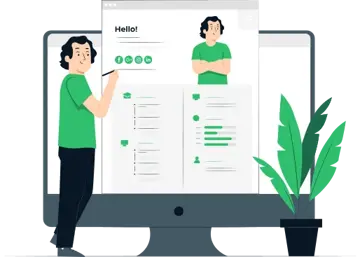
Build your Resume in 15 minutes
Create an awesome resume that meets the expectations of potential employers with our selection of professional, field-tested resume templates.

